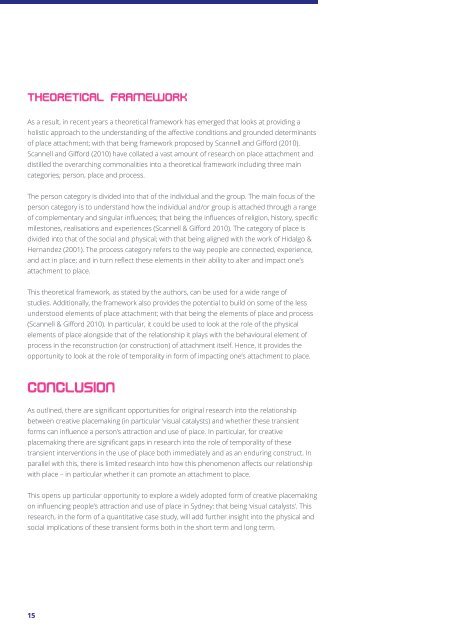Exploring the Role of 'Visual Catalysts' on Influencing People's Attraction and Use of Place
Undergraduate Thesis // Keegan Lovell // Bachelor of Landscape Architecure // UNSW 2016
Undergraduate Thesis // Keegan Lovell // Bachelor of Landscape Architecure // UNSW 2016
Create successful ePaper yourself
Turn your PDF publications into a flip-book with our unique Google optimized e-Paper software.
THEORETICAL FRAMEWORK<br />
As a result, in recent years a <str<strong>on</strong>g>the</str<strong>on</strong>g>oretical framework has emerged that looks at providing a<br />
holistic approach to <str<strong>on</strong>g>the</str<strong>on</strong>g> underst<strong>and</strong>ing <str<strong>on</strong>g>of</str<strong>on</strong>g> <str<strong>on</strong>g>the</str<strong>on</strong>g> affective c<strong>on</strong>diti<strong>on</strong>s <strong>and</strong> grounded determinants<br />
<str<strong>on</strong>g>of</str<strong>on</strong>g> place attachment; with that being framework proposed by Scannell <strong>and</strong> Gifford (2010).<br />
Scannell <strong>and</strong> Gifford (2010) have collated a vast amount <str<strong>on</strong>g>of</str<strong>on</strong>g> research <strong>on</strong> place attachment <strong>and</strong><br />
distilled <str<strong>on</strong>g>the</str<strong>on</strong>g> overarching comm<strong>on</strong>alities into a <str<strong>on</strong>g>the</str<strong>on</strong>g>oretical framework including three main<br />
categories; pers<strong>on</strong>, place <strong>and</strong> process.<br />
The pers<strong>on</strong> category is divided into that <str<strong>on</strong>g>of</str<strong>on</strong>g> <str<strong>on</strong>g>the</str<strong>on</strong>g> individual <strong>and</strong> <str<strong>on</strong>g>the</str<strong>on</strong>g> group. The main focus <str<strong>on</strong>g>of</str<strong>on</strong>g> <str<strong>on</strong>g>the</str<strong>on</strong>g><br />
pers<strong>on</strong> category is to underst<strong>and</strong> how <str<strong>on</strong>g>the</str<strong>on</strong>g> individual <strong>and</strong>/or group is attached through a range<br />
<str<strong>on</strong>g>of</str<strong>on</strong>g> complementary <strong>and</strong> singular influences; that being <str<strong>on</strong>g>the</str<strong>on</strong>g> influences <str<strong>on</strong>g>of</str<strong>on</strong>g> religi<strong>on</strong>, history, specific<br />
milest<strong>on</strong>es, realisati<strong>on</strong>s <strong>and</strong> experiences (Scannell & Gifford 2010). The category <str<strong>on</strong>g>of</str<strong>on</strong>g> place is<br />
divided into that <str<strong>on</strong>g>of</str<strong>on</strong>g> <str<strong>on</strong>g>the</str<strong>on</strong>g> social <strong>and</strong> physical; with that being aligned with <str<strong>on</strong>g>the</str<strong>on</strong>g> work <str<strong>on</strong>g>of</str<strong>on</strong>g> Hidalgo &<br />
Hern<strong>and</strong>ez (2001). The process category refers to <str<strong>on</strong>g>the</str<strong>on</strong>g> way people are c<strong>on</strong>nected, experience,<br />
<strong>and</strong> act in place; <strong>and</strong> in turn reflect <str<strong>on</strong>g>the</str<strong>on</strong>g>se elements in <str<strong>on</strong>g>the</str<strong>on</strong>g>ir ability to alter <strong>and</strong> impact <strong>on</strong>e’s<br />
attachment to place.<br />
This <str<strong>on</strong>g>the</str<strong>on</strong>g>oretical framework, as stated by <str<strong>on</strong>g>the</str<strong>on</strong>g> authors, can be used for a wide range <str<strong>on</strong>g>of</str<strong>on</strong>g><br />
studies. Additi<strong>on</strong>ally, <str<strong>on</strong>g>the</str<strong>on</strong>g> framework also provides <str<strong>on</strong>g>the</str<strong>on</strong>g> potential to build <strong>on</strong> some <str<strong>on</strong>g>of</str<strong>on</strong>g> <str<strong>on</strong>g>the</str<strong>on</strong>g> less<br />
understood elements <str<strong>on</strong>g>of</str<strong>on</strong>g> place attachment; with that being <str<strong>on</strong>g>the</str<strong>on</strong>g> elements <str<strong>on</strong>g>of</str<strong>on</strong>g> place <strong>and</strong> process<br />
(Scannell & Gifford 2010). In particular, it could be used to look at <str<strong>on</strong>g>the</str<strong>on</strong>g> role <str<strong>on</strong>g>of</str<strong>on</strong>g> <str<strong>on</strong>g>the</str<strong>on</strong>g> physical<br />
elements <str<strong>on</strong>g>of</str<strong>on</strong>g> place al<strong>on</strong>gside that <str<strong>on</strong>g>of</str<strong>on</strong>g> <str<strong>on</strong>g>the</str<strong>on</strong>g> relati<strong>on</strong>ship it plays with <str<strong>on</strong>g>the</str<strong>on</strong>g> behavioural element <str<strong>on</strong>g>of</str<strong>on</strong>g><br />
process in <str<strong>on</strong>g>the</str<strong>on</strong>g> rec<strong>on</strong>structi<strong>on</strong> (or c<strong>on</strong>structi<strong>on</strong>) <str<strong>on</strong>g>of</str<strong>on</strong>g> attachment itself. Hence, it provides <str<strong>on</strong>g>the</str<strong>on</strong>g><br />
opportunity to look at <str<strong>on</strong>g>the</str<strong>on</strong>g> role <str<strong>on</strong>g>of</str<strong>on</strong>g> temporality in form <str<strong>on</strong>g>of</str<strong>on</strong>g> impacting <strong>on</strong>e’s attachment to place.<br />
CONCLUSION<br />
As outlined, <str<strong>on</strong>g>the</str<strong>on</strong>g>re are significant opportunities for original research into <str<strong>on</strong>g>the</str<strong>on</strong>g> relati<strong>on</strong>ship<br />
between creative placemaking (in particular ‘visual catalysts) <strong>and</strong> whe<str<strong>on</strong>g>the</str<strong>on</strong>g>r <str<strong>on</strong>g>the</str<strong>on</strong>g>se transient<br />
forms can influence a pers<strong>on</strong>’s attracti<strong>on</strong> <strong>and</strong> use <str<strong>on</strong>g>of</str<strong>on</strong>g> place. In particular, for creative<br />
placemaking <str<strong>on</strong>g>the</str<strong>on</strong>g>re are significant gaps in research into <str<strong>on</strong>g>the</str<strong>on</strong>g> role <str<strong>on</strong>g>of</str<strong>on</strong>g> temporality <str<strong>on</strong>g>of</str<strong>on</strong>g> <str<strong>on</strong>g>the</str<strong>on</strong>g>se<br />
transient interventi<strong>on</strong>s in <str<strong>on</strong>g>the</str<strong>on</strong>g> use <str<strong>on</strong>g>of</str<strong>on</strong>g> place both immediately <strong>and</strong> as an enduring c<strong>on</strong>struct. In<br />
parallel with this, <str<strong>on</strong>g>the</str<strong>on</strong>g>re is limited research into how this phenomen<strong>on</strong> affects our relati<strong>on</strong>ship<br />
with place – in particular whe<str<strong>on</strong>g>the</str<strong>on</strong>g>r it can promote an attachment to place.<br />
This opens up particular opportunity to explore a widely adopted form <str<strong>on</strong>g>of</str<strong>on</strong>g> creative placemaking<br />
<strong>on</strong> influencing people’s attracti<strong>on</strong> <strong>and</strong> use <str<strong>on</strong>g>of</str<strong>on</strong>g> place in Sydney; that being ‘visual catalysts’. This<br />
research, in <str<strong>on</strong>g>the</str<strong>on</strong>g> form <str<strong>on</strong>g>of</str<strong>on</strong>g> a quantitative case study, will add fur<str<strong>on</strong>g>the</str<strong>on</strong>g>r insight into <str<strong>on</strong>g>the</str<strong>on</strong>g> physical <strong>and</strong><br />
social implicati<strong>on</strong>s <str<strong>on</strong>g>of</str<strong>on</strong>g> <str<strong>on</strong>g>the</str<strong>on</strong>g>se transient forms both in <str<strong>on</strong>g>the</str<strong>on</strong>g> short term <strong>and</strong> l<strong>on</strong>g term.<br />
15


